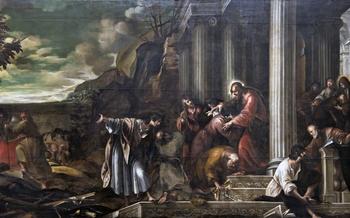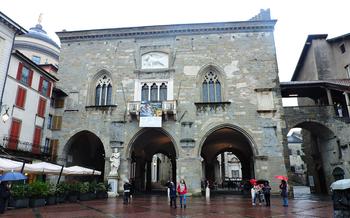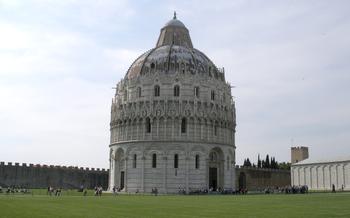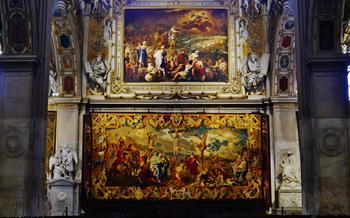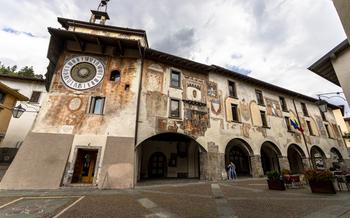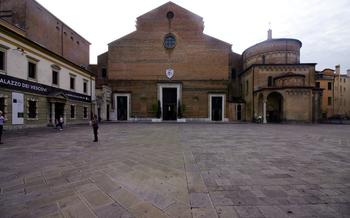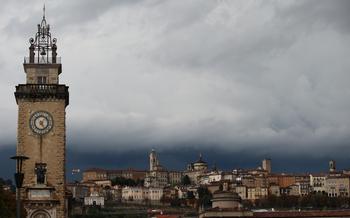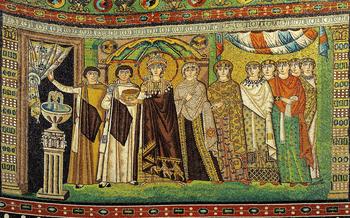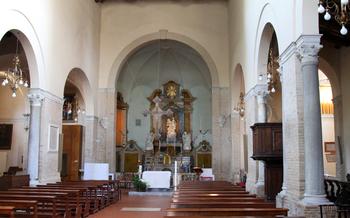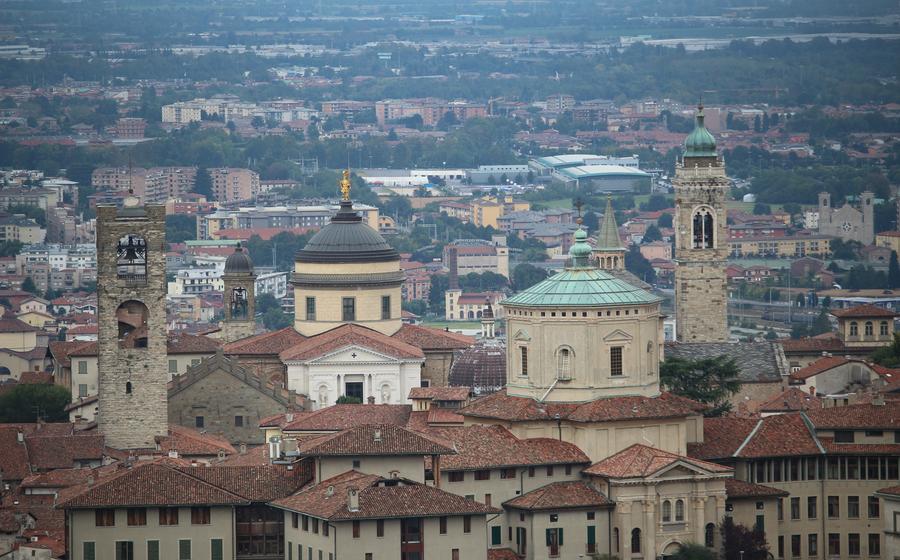
Battistero di San Giovanni Battista (Baptistery of Saint John the Baptist)
- The Baptistery of Saint John the Baptist: A Timeless Masterpiece in the Heart of Bergamo
- History and Architecture
- Exterior Beauty
- Interior Grandeur
- Baptismal Significance
- Symbolism of the Lion
- Collaboration of Masters
- Local Legends and Myths: A Touch of Enchantment
- Photography Tips
- Dress Code and Etiquette
- Insider Tip: Unveiling the Hidden Treasure
The Baptistery of Saint John the Baptist: A Timeless Masterpiece in the Heart of Bergamo
Nestled in the enchanting city of Bergamo, Italy, the Baptistery of Saint John the Baptist stands as a testament to the city's rich history and profound religious significance. This architectural masterpiece, dating back to the 12th century, is a remarkable example of Romanesque style, blending harmoniously with the city's medieval character. As one of the most iconic landmarks in Bergamo, the Baptistery invites visitors to embark on a journey through time, spirituality, and artistic brilliance. Prepare to be captivated by its exquisite beauty, intriguing symbolism, and enduring legacy that has made it a beloved symbol of Bergamo's cultural heritage.
History and Architecture
The history of the Baptistery of Saint John the Baptist is intertwined with the rich tapestry of Bergamo's past. Its construction, initiated in the 12th century, spanned over 200 years, reflecting the city's evolving artistic and cultural influences. The Romanesque style prevalent in the lower section gives way to Gothic elements in the upper portion, showcasing the transition in architectural trends.
The Baptistery's exterior, adorned with intricate Lombard Romanesque carvings and sculptures, narrates biblical stories and depicts mythical creatures. These intricate details, a testament to the skill of medieval artisans, invite visitors to embark on a visual journey through time.
The imposing dome, a defining feature of the Baptistery, stands as a symbol of Bergamo's architectural prowess. Its octagonal shape and ribbed vaults echo the grandeur of early Christian and Byzantine structures. The dome's interior, embellished with stunning frescoes, adds a touch of ethereal beauty to the Baptistery's already awe-inspiring presence. In essence, the Baptistery of Saint John the Baptist is a testament to the architectural prowess and artistic vision that shaped Bergamo's medieval landscape.
Exterior Beauty
The Baptistery of San Giovanni Battista captivates visitors with its alluring exterior, a testament to the artistry and craftsmanship of its creators. Intricate carvings and sculptures adorn the façade, telling tales from the Bible and the history of Bergamo. The lower part features a series of blind arcades, creating a rhythmic pattern of alternating solids and voids. Above them, a row of slender columns supports a gallery, where delicate arches intertwine, echoing the elegant Gothic style that permeates the city's architecture.
The Baptistery's crowning glory is its majestic dome, a symbol of both religious devotion and architectural prowess. Its ribbed structure rises high into the sky, creating a sense of awe and wonder. The exterior of the dome is adorned with intricate geometric patterns and small sculptures, adding depth and texture to the overall design.
One cannot help but admire the impressive entrance portal, a masterpiece of Romanesque artistry. Its intricate carvings depict scenes from the life of Jesus Christ, the Virgin Mary, and various saints. The lintel above the doorway features a relief of the Baptism of Christ, a fitting symbol for a building dedicated to the sacrament of baptism.
The exterior of the Baptistery of San Giovanni Battista is a true work of art, a testament to the skill and devotion of those who created it. Every detail, from the delicate carvings to the towering dome, contributes to the building's overall splendor, making it a must-see for any visitor to Bergamo.
Interior Grandeur
Stepping inside the Baptistery of Saint John the Baptist is a transcendent experience, as visitors are greeted by an opulent and awe-inspiring interior. The walls and ceiling are adorned with a symphony of stunning frescoes and mosaics, each narrating a biblical story or depicting a celestial scene. These intricate and colorful artworks transport visitors to a realm of spiritual wonder and artistic mastery.
At the heart of the Baptistery lies its most captivating feature: the intricately carved baptismal font. This octagonal masterpiece is supported by eight lion sculptures, symbolizing strength and courage. The font's intricate carvings showcase biblical scenes and figures, inviting visitors to contemplate the sacred act of baptism and the spiritual transformation it represents.
The ceiling of the Baptistery is a celestial spectacle, featuring a mosaic depicting the heavens and the twelve apostles. The vibrant colors and intricate details of the mosaic create an illusion of boundless space, drawing visitors' eyes upwards towards the divine realm. The interplay of natural light filtering through the windows illuminates the interior, casting a warm glow that enhances the grandeur of the frescoes and mosaics.
The interior of the Baptistery is a testament to the artistic and spiritual prowess of its creators. It is a space that invites contemplation, reflection, and a profound connection to the sacred. Every inch of the interior is imbued with symbolism and beauty, creating an unforgettable experience for visitors who step across its threshold.
Baptismal Significance
The Baptistery of San Giovanni Battista holds immense religious significance as a sacred place of baptism for the Christian community in Bergamo. Since its inception, the Baptistery has served as a symbol of spiritual rebirth and purification, where countless individuals have embarked on their Christian journey through the sacrament of baptism.
The baptismal font, situated at the heart of the Baptistery, is an exquisite work of art in itself. It is an octagonal-shaped basin, finely crafted from red marble and adorned with intricate carvings depicting scenes from the life of Jesus Christ. The font stands as a physical representation of the spiritual cleansing that takes place through the act of baptism.
Throughout the centuries, the Baptistery has witnessed countless baptisms, each carrying its own unique story of faith and devotion. The echoes of prayers and the whispers of baptismal vows still linger within its ancient walls, creating a palpable sense of spirituality.
Symbolically, the Baptistery represents the gateway to the Christian faith, where individuals embrace the teachings of Jesus Christ and become part of the wider Christian community. It is a place where new believers begin their spiritual journey, seeking guidance and strength as they navigate their lives in accordance with Christian principles.
The Baptistery of San Giovanni Battista stands as a testament to the enduring power of faith and the significance of the baptismal sacrament in the Christian tradition. It invites visitors to contemplate the spiritual journey that unfolds within its walls, fostering a deeper connection to the history and culture of Bergamo.
Symbolism of the Lion
The lion, a symbol of strength, courage, and nobility, holds a prominent place in the iconography of the Baptistery. Lions feature prominently in sculptures, carvings, and decorative elements throughout the building, serving as both religious and civic symbols. In a religious context, the lion represents the strength of faith and the triumph of good over evil. It is often depicted as a guardian figure, protecting the entrance to the Baptistery and symbolizing the spiritual protection offered to those who enter.
From a civic perspective, the lion is a symbol of Bergamo itself. The city's coat of arms features a winged lion, representing the city's strength, independence, and proud history. The lion's presence in the Baptistery reinforces the deep connection between the building and the city it serves, embodying the shared values and identity of the Bergamasque people.
Collaboration of Masters
The creation of the Baptistery of Saint John the Baptist was a collaborative effort of renowned artists and craftsmen who left their indelible mark on the edifice. Among them stands Arnolfo di Cambio, a renowned 13th-century sculptor and architect, credited with designing the Baptistery's intricate façade. His genius is evident in the elegant carvings and sculptures that adorn the exterior, showcasing his mastery in handling stone and creating lifelike figures.
Within the Baptistery's hallowed interior, the frescoes and mosaics that grace the walls and ceiling were meticulously crafted by a collective of talented artists. Giovanni da Campione, a renowned painter and mosaicist, played a pivotal role in creating the stunning frescoes depicting scenes from the life of John the Baptist and other biblical narratives. His vibrant colors and expressive brushstrokes bring the stories to life, immersing viewers in the sacred tales.
The intricate baptismal font, the centerpiece of the Baptistery, is a testament to the artistry of Bonino da Campione, a master sculptor known for his exceptional work in bronze. The intricate carvings and reliefs adorning the font, depicting scenes of baptism and the life of Christ, showcase his technical prowess and artistic vision.
The collective talent and expertise of these master artists and craftsmen culminated in the creation of a masterpiece that transcended the limitations of time and continues to captivate visitors with its artistic grandeur and spiritual significance.
Local Legends and Myths: A Touch of Enchantment
The Baptistery of Saint John the Baptist in Bergamo is not just a remarkable architectural wonder; it is also a place steeped in legend and myth. One of the most captivating tales is associated with the baptistery's iconic lion symbol, which is said to possess magical powers. According to local folklore, the lion protects the city from harm and misfortune, ensuring its safety and prosperity.
Another intriguing legend tells the story of a brave knight who was battling a fearsome dragon that threatened the city. As the knight fought valiantly, he heard a voice from the heavens guiding him to the baptistery. There, he discovered a hidden weapon that helped him slay the dragon, saving the city from its clutches.
These legends and myths have become an integral part of the Baptistery's allure, adding a touch of enchantment to its already awe-inspiring presence. They serve as a reminder that the Baptistery is more than just a historical landmark; it is a symbol of Bergamo's rich cultural heritage and the enduring power of human imagination.
Photography Tips
The Baptistery of Saint John the Baptist offers a wealth of opportunities for capturing stunning photographs. To make the most of your visit, consider the following tips:
-
Play with angles: Experiment with different angles to create dynamic compositions. Shoot from low angles to emphasize the height and grandeur of the building, or from eye level to capture the intricate details of the carvings.
-
Lighting matters: Visit during the golden hour, just after sunrise or before sunset, when the warm light casts a magical glow on the Baptistery's exterior. For interior shots, take advantage of the natural light that streams through the windows, creating beautiful patterns and highlights.
-
Details make a difference: Zoom in to capture the exquisite details of the carvings, sculptures, and frescoes. Look for patterns, textures, and interesting juxtapositions that add depth and visual interest to your photographs.
-
Use a tripod: A tripod will help you stabilize your camera, especially for long exposures or low-light conditions. This will ensure sharp and blur-free images, allowing you to capture the Baptistery's beauty in all its glory.
-
Play with perspectives: Incorporate elements of the surrounding environment into your shots to create visually appealing compositions. Frame the Baptistery with trees, buildings, or the picturesque streets of Bergamo to add depth and context to your photographs.
Dress Code and Etiquette
The Baptistery of Saint John the Baptist is a sacred place of worship and a testament to Bergamo's religious heritage. As such, visitors are expected to maintain a respectful demeanor and dress code when visiting the site. While there is no strict dress code, it is advisable to dress modestly and avoid revealing or overly casual attire. Shorts, tank tops, and flip-flops are generally not considered appropriate. It is also customary to cover one's shoulders and knees, especially for women.
Beyond attire, visitors are encouraged to be mindful of their behavior within the Baptistery. This includes maintaining a quiet and reverent atmosphere, refraining from loud conversations or disruptive noises. Taking photographs is permitted, but using flash photography or tripods is prohibited. Respecting the sanctity of the Baptistery and the religious practices that take place within its walls ensures a harmonious and meaningful experience for all visitors.
Insider Tip: Unveiling the Hidden Treasure
Beyond the captivating beauty that meets the eye, the Baptistery of Saint John the Baptist holds a secret that only the locals know. Behind the altar, concealed by a discreet door, lies a hidden chamber that once served as a treasury. This secret room, now accessible to the public, reveals a treasure trove of ancient artifacts, including precious reliquaries, intricate goldsmith work, and sacred manuscripts. It's a glimpse into the rich history and devotion of Bergamo's past, offering a unique perspective on the Baptistery's profound religious significance.
